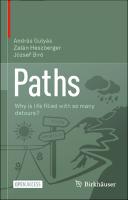Paths
Why is life filled with so many detours?
| dc.contributor.author | Gulyás, András | |
| dc.contributor.author | Heszberger, Zalán | |
| dc.contributor.author | Biró, József | |
| dc.date.accessioned | 2020-09-21T13:42:27Z | |
| dc.date.available | 2020-09-21T13:42:27Z | |
| dc.date.issued | 2021 | |
| dc.identifier | ONIX_20200921_9783030475451_116 | |
| dc.identifier | OCN: 1192490022 | |
| dc.identifier.uri | https://library.oapen.org/handle/20.500.12657/41760 | |
| dc.description.abstract | This open access book explores the amazing similarity between paths taken by people and many other things in life, and its impact on the way we live, teach and learn. Offering insights into the new scientific field of paths as part of the science of networks, it entertainingly describes the universal nature of paths in large networked structures. It also shows the amazing similarity in the ways humans and other – even nonliving – things navigate in a complex environment, to allow readers to easily grasp how paths emerge in many walks of life, and how they are navigated. Paths is based on the authors recent research in the area of paths on networks, which points to the possible birth of the new science of “paths” as a natural consequence ‘and extension) of the science of “networks.” The approach is essentially story-based, supported by scientific findings, interdisciplinary approaches, and at times, even philosophical points of view. It also includes short illustrative anecdotes showing the amazing similarities between real-world paths and discusses their applications in science and everyday life. Paths will appeal to network scientists and to anyone interested in popular science. By helping readers to step away from the “networked” view of many recent popular scientific books and start to think of longer paths instead of individual links, it sheds light on these problems from a genuinely new perspective. --------------------------------------------------------------------------------- The path is the goal. The essence behind this short sentence is known to many people around the world, expressed through the interpretations of some of the greatest thinkers like Lao-Tze and Gandhi. It means that it is the journey that counts, not the destination. When speaking about such subjective and intangible things, philosophy and religion are some of the only approaches that are addressed. In this book, the authors address this conventional wisdom from the perspective of natural science. They explore a sequence of steps that leads the reader closer to the nature of paths and accompany him on the search for “the path to paths”. | |
| dc.language | English | |
| dc.subject.classification | thema EDItEUR::P Mathematics and Science::PD Science: general issues::PDZ Popular science::PDZM Popular and recreational mathematics | en_US |
| dc.subject.other | Popular Science in Mathematics | |
| dc.subject.other | Mathematics | |
| dc.subject.other | network science | |
| dc.subject.other | graph theory | |
| dc.subject.other | path | |
| dc.subject.other | shortest path | |
| dc.subject.other | internet | |
| dc.subject.other | brain | |
| dc.subject.other | routing policy | |
| dc.subject.other | social networks | |
| dc.subject.other | artificial networks | |
| dc.subject.other | computer networks | |
| dc.subject.other | road networks | |
| dc.subject.other | open access | |
| dc.subject.other | Popular and recreational mathematics | |
| dc.title | Paths | |
| dc.title.alternative | Why is life filled with so many detours? | |
| dc.type | book | |
| oapen.identifier.doi | 10.1007/978-3-030-47545-1 | |
| oapen.relation.isPublishedBy | 6c6992af-b843-4f46-859c-f6e9998e40d5 | |
| oapen.imprint | Birkhäuser | |
| oapen.pages | 86 |

